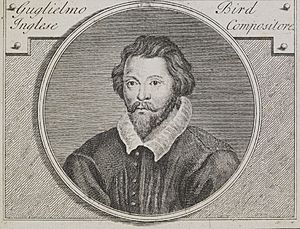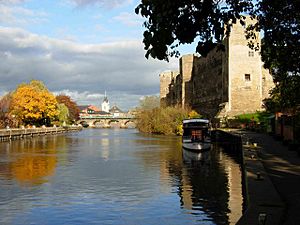Robert Parsons (composer) facts for kids
Quick facts for kids
Robert Parsons
|
|
|---|---|
| Born | ca. 1535 Exeter, Devon
|
| Died | ca. 1572 (aged 36–37) Newark-on-Trent, Nottinghamshire
|
| Occupation | Composer |
| Known for | Anglican church music |
|
Notable work
|
The First Service; Ave Maria; In manus tuas |
Robert Parsons was an English composer who lived a long time ago, during the time of the Tudor kings and queens. He wrote music for the church. He was active when King Edward VI, Queen Mary I, and Queen Elizabeth I were in charge.
Contents
Early Life of Robert Parsons
Robert Parsons was born around 1535. We don't know many details about his early life. It's likely he was a choir boy when he was young. This is because he worked as an assistant to Richard Bower. Bower was the Master of the Children of the Chapel Royal until 1561.
Parsons' Music Career and Impact

Parsons wrote music during a time of big religious changes in England. After Henry VIII died in 1547, King Edward VI brought in new rules for the church. The old church services were in Latin. But in 1549, the new Book of Common Prayer changed everything. Services were now in English.
This meant that new music was needed for the church. Composers like Parsons, Thomas Tallis, and John Sheppard had to write songs in English. They showed that the new Protestantism could be just as grand as the old Catholic ways.
When Queen Mary I ruled (1553–1558), Catholic practices came back. So, Latin music was popular again. But after Queen Elizabeth I became queen in 1558, English church music became important once more.
Parsons became a Gentleman of the Chapel Royal in 1563. He wrote many songs for both church and everyday life. His earliest known work is The First Service. This was a setting of words from the 1549 Prayer Book. It is his biggest work that we still have today. This work suggests he was writing music from the early 1550s.
The First Service included music for:
- Morning Prayer (like Te Deum)
- Evening Prayer (like Magnificat)
- The Credo and short Responses for the Holy Communion service.
Parsons was especially known for his motets, which are choral pieces. He was a master of polyphony, which means writing music with many independent voice parts. He used a technique called cantus firmus very well in his songs. Some of his famous works include Ave Maria and the anthem Deliver me from mine enemies. He also wrote some instrumental pieces.
Many of his songs were put into important music books of the time. Parsons was the first English composer to write music for the Office for the Dead. He might have been inspired by Alfonso Ferrabosco, an Italian composer who worked in England.
Parsons also worked with other musicians. He may have helped Richard Farrant with plays in the early 1560s. His music style was similar to John Sheppard's. Parsons also had a big influence on the famous composer William Byrd. Parsons's ideas can be seen in Byrd's instrumental and choral works. Parsons and Byrd both lived and worked in Lincolnshire. Parsons lived only a few miles from where Byrd lived. It is thought that Parsons might have taught Byrd at Lincoln Cathedral.
Robert Parsons' Musical Works
Parsons wrote music in both English and Latin.
English Compositions
- The First Service (also known as The Great Service)
- The Second 'Excellent' Service for Means (evening songs for the Second Service were finished by William Mundy to honor Parsons)
English Anthems
- Deliver me from mine enemies
- Holy Lord God Almighty
Consort Songs
- Abradad: Alas you salt sea gods
- Enforced by Love and Fear
- No grief is like to mine
- Pour down you powers divine
Latin Compositions
- Ave Maria
- Credo quod redemptor meus vivit
- Domine, quis habitabit
- Iam Christus astra ascenderat
- In manus tuas
- Retribue servo tuo
- Libera me, Domine, de morte aeterna
- Magnificat
- O bone Jesu
- Peccantem me quotidie
Death and Lasting Impact
Robert Parsons likely died in January 1572. He fell into the River Trent near Newark-on-Trent and drowned. The river was very high at the time. His death was a sad event because he was a very respected composer. People felt sad that his life ended so young. A tribute written about him said:
Qui tantus primo Parsone in flore fuisti, quantus in autumno in morerer flores
("You who were so great, Parsons, in life's springtime, how great you would have been in autumn, had death not intervened")
Parsons's body was never found after he drowned. His son, John Parsons, also became a composer. He was an organist at Westminster Abbey. William Byrd took Parsons's place as Gentleman of the Chapel Royal.
Today, Parsons's music is still performed in churches. His Ave Maria was even included in a famous music book called the Oxford Book of Tudor Anthems in 1978.
See also
- Tudor music
- List of Anglican church composers



